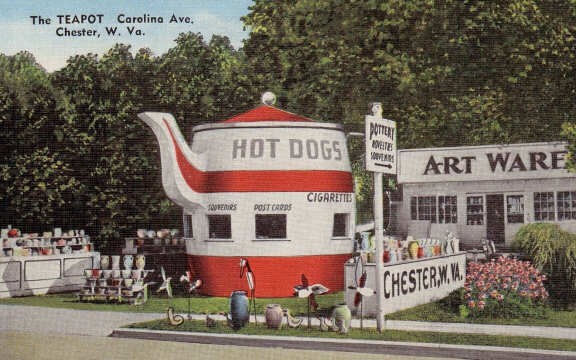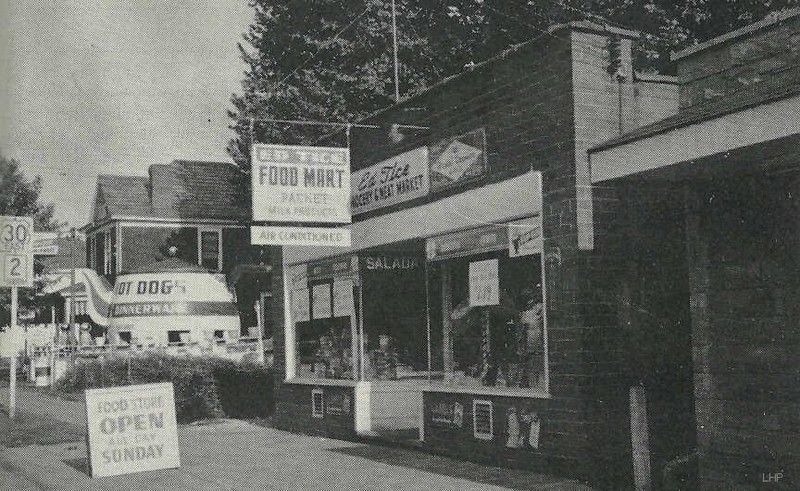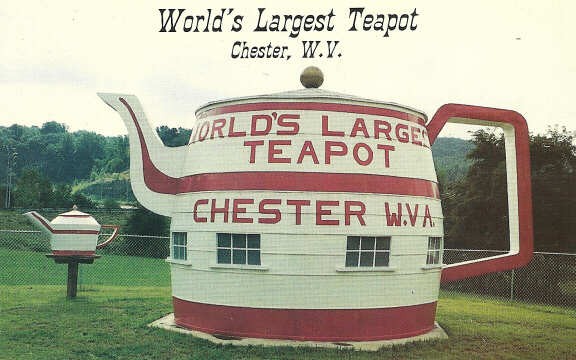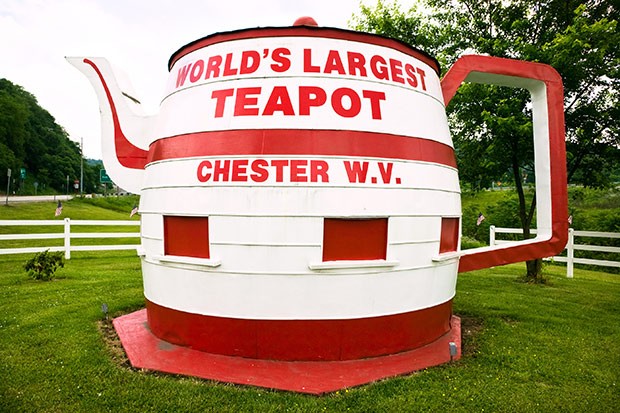The World's Largest Teapot
Introduction
Text-to-speech Audio
Located in Chester, this 14-foot teapot is the largest in the world. The teapot represents the significance of the pottery industry in the region since 1938. In 1990, the restoration of this teapot was conducted and completed by a group of citizens from the City of Chester, WV. The World's Largest Teapot has become a major tourist attraction attracting a number of visitors from all over the United States. Come and visit to learn more about the history behind this giant teapot.
Images
World's Largest Teapot postcard from the 1950s. This is a colorized version of a Black and white postcard.

Advert for the Ed Tice Food Mart. 118 Carolina Ave, Chester, WV. In the background is the Teapot when it was used as a hot dog stand. Photo from a 1959 Polaris yearbook.

World's Largest Teapot postcard from the 1990s. The little teapot/creamer on the left is presently in City Hall.

World's Largest Teapot today

Backstory and Context
Text-to-speech Audio
In 1938, William Devon purchased the barrel in Pennsylvania and shipped it to Chester. After that, the Chester Teapot was constructed by William Devon on Carolina Avenue (also known as State Route 2). As a gigantic wooden hogshead barrel, the Chester Teapot used in advertising campaign of Hire’s Root Beer. With a unique design “A spout and handle were added at this time and the wooden barrel was covered with tin to form the teapot's shape. A large glass ball was placed on top to make the knob of the lid” (1). To run a concession and souvenir shop, the local teenagers were hired to work inside the Teapot. It created the new image for Devon’s project.The Chester Teapot was closed for two years during the World War II, and in 1947, the Chester Teapot and Devon’s pottery business were sold to Mary Wecherer and Rhelda Cain. The teapot was used to sell food as well as lawn and garden items. The teapot was operating for business’s profit until the late 1960’s.
Thereafter, once again in 1971, the Teapot was purchased by Cecil and Alice Fletcher. The Fletcher had painted the Teapot by the colors of blue and while. And they continued their business by selling pottery and souvenir. However, the Fletchers finally closed their business and shut down the Chester Teapot afterward.
In 1984, C&P Telephone purchased the land where the Teapot stood on. The old building was dismantled and the Teapot was in danger of being torn down. To deal with this danger, a group of citizens led by a Chester native- Geneva Hill was formed to take an action for saving and preserving the Chester Teapot.
After 3 years, in 1987, the Councilwoman Anne Ford had formed a restoration committee to conduct saving project of The Chester Teapot. The restoration of Chester Teapot was started and the teapot was moved to various places in Chester. However, many problems and debates came up and finally the Ford’s committee was disbanded and Chester Teapot’s restoration were halted.
Thereafter, the Teapot was moved to Jennings Randolph Bridge Ramp which is known as a heavily trafficked area at the junction of State Route 2 and U.S. Route 30. Furthermore, the State had donated the property and a fence surround the Chester Teapot. And Tri-State Pottery Festival Association had donated a concrete pad to place the Teapot on. In the summer of 1990, the Teapot’s restoration was completely finished by Sayre Graham, Mayor Roy Cashdollar and other volunteers.
The Chester Teapot performed itself in the original colors of red and white. On October 12, 1990, the Chester Teapot was dedicated at a ceremony held in Chester’s community center.The Chester Teapot is also known as the World’s Largest Teapot and has become a local attraction where attract a large number of visitors to stop by in their journey
Sources
(1)" History of "The World's Largest Teapot". Chester Library WV. Retrieved Mar 17, 2015 from http://chester.lib.wv.us/teapot.html
